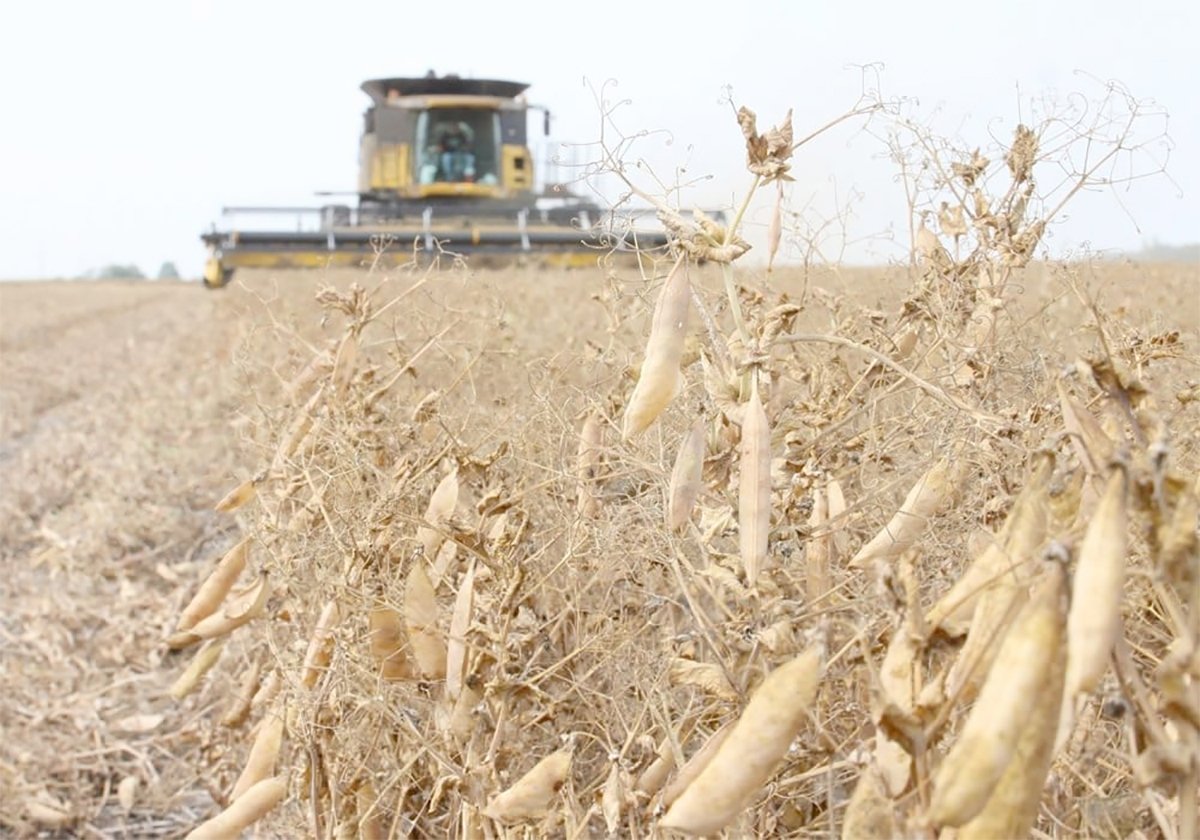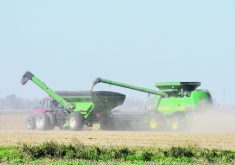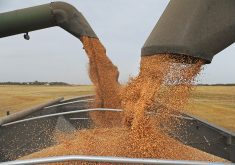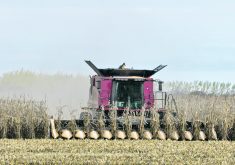Manitoba
SOUTHWEST
Rainfall put a damper on seeding efforts while cool conditions slowed crop growth, but crops are quickly emerging.
Most areas reported 15 to 30 millimetres of rain.
Unseeded acres will average five to 10 percent, but some farms will see 25 to 30 percent.
Seeding is almost finished, but the southwestern corner is only 30 to 40 percent complete.
Producers are applying fungicide and herbicide for early seeded cereals showing moisture stress and disease.
Fall rye is heading, and most winter wheat is in the flag leaf stage. Most broadcast seeded canola has emerged. Pressure from insect damage is generally low.
Read Also

Chinese, Indian tariffs take toll on pea prices
The disruption of pea exports from Canada’s largest customers will likely result in slow pea exports for the remainder of the crop year.
The lack of heat and sunshine is slowing forage growth, but pastures are growing well. Most alfalfa stands are in the early to mid bud stage. Dairy producers have started their first cut of silage, and commercial hay growers will be soon cutting.
NORTHWEST
Twelve to 51 mm of rain continued to restrain seeding efforts, and many fields have standing water in low-lying areas. Excessive topsoil moisture has some producers looking for higher ground that could support seeding equipment. Seeding on average is almost complete.
All crops are showing good germination and even emergence, despite excess moisture. Producers are also applying in-crop herbicide. Reports of insect activity remain low.
Dandelion growth is an issue in some hay fields and pastures, while forage growth has been slow because of below average temperatures.
Dugouts in some areas have overflowed their banks onto surrounding fields.
CENTRAL
Seeding is basically complete, but some crops show uneven development because of the stops and starts caused by rain.
Most areas saw cool temperatures with precipitation of 40 to 60 mm. Standing water is quickly being absorbed in many cases, but any amount on saturated soil shuts down field operations.
Crops are generally growing well with good, even emergence. Several pea fields required rolling.
Herbicide applications are complete on winter wheat, and most cereals have been sprayed.
Crop development is uneven, which will make fungicide applications a challenge to time properly. Second applications or broadleaf applications are being made in most canola fields. Most soybeans have seen the first application.
Pressure from flea beetles and cutworms continues but is beginning to wane in most areas. However, some fields had to be reseeded.
Diamondback and bertha armyworm moth numbers remain low, but high numbers of grasshoppers have been reported in some areas.
EASTERN
Rainfall ranging from 40 to 105 mm brought seeding to an end, which leaves five to 10 percent unseeded. Most topsoil moisture conditions are rated surplus to adequate. Many fields have standing water.
Excess rainfall is preventing fungicide applications on most fields.
Flea beetles in canola are still causing concerns with some post-emergent spraying and reseeding occurring.
There are reports of cutworms in sunflowers, corn and canola. Grasshopper nymphs are found with extensive damage on some field margins.
INTERLAKE
Seeding is generally complete with trace amounts of specialty crops remaining, but excess moisture and unseasonably cool temperatures are slowing production.
Accumulated rainfall across the area ranged from 35 to 75 mm. Field drains are full in some places with road ditches and water drains close to full.
Recent precipitation is delaying herbicide applications for several days.
There are reports of sunflower damage caused by cutworms.
Saskatchewan
SOUTH
Little seeding or spraying progress was made because of cool, wet conditions. Some fields will go unseeded, but some producers hope to seed greenfeed crops. Haying operations should soon begin.
The Bengough area recorded the highest amount of rainfall with 60 mm.
Topsoil moisture conditions for cropland, hayland and pastures average 80 percent adequate.
Most crops are in fair to excellent condition but are behind normal stages of development.
Reported crop damage is from localized flooding, frost, hail, wind and insects.
CENTRAL
Many farmers were able to continue their seeding efforts despite excess moisture, but many fields will go unseeded, particularly in the eastern half of the region. Some producers may still be able to seed greenfeed crops.
The Rhein area received the most precipitation with 48 mm. Since April 1, the Craik area has received the most rainfall with 245 mm.
Most topsoil moisture conditions for cropland, hayland and pastures are in good condition, but several eastern areas are seeing continued deterioration.
Most crops are behind their normal development stages but are in fair to excellent condition. Cool weather has hindered plant growth in many pastures.
Crop damage is attributed to localized flooding, frost, hail and insects such as flea beetles, wireworms and cutworms.
Some crops are yellowing because of excess moisture.
Wet conditions and high winds, particularly in eastern areas, are delaying spraying with reports of stuck equipment in muddy fields.
NORTHERN
Seeding is mostly complete, although some areas will see greenfeed crops seeded. Haying operations are underway.
The Garrick area received 58 mm of rain while the Hafford area recorded the highest amount since April 1 with 249 mm.
Conditions are excellent for most cropland, hayland and pastures.
Localized flooding, wind, insects and light frost were reported. Most crops are in fair to excellent condition, but warm weather is needed to curb delayed development.
Producers sprayed for cutworms in canola crops as weather permitted and applied post-seeding fertilizer to emerged crops.
Alberta
SOUTH
Cool temperatures and heavy precipitation have delayed crop development seven to 10 days.
Surface moisture conditions are excellent for most cropland, while pastures and tame hay are good.
Weed spraying is about half complete. Many areas report problems with flea beetles and gophers.
Some of the earliest seeded canola will soon be on the cusp of flowering, and producers will need to scout for cabbage seedpod weevil. Also, some wheat may soon begin to head out, which raises concern for wheat midge.
CENTRAL
Most areas received spotty showers and cooler temperatures. Delayed crops would benefit from warmer temperatures and more precipitation.
Surface soil moisture was downgraded with about half in good condition.
Pastures and tame hay are faring better with more than half rated in good condition.
Less than half of spraying is complete, and most areas have issues with flea beetles and gophers.
NORTHEAST
Crop development was helped significantly with the combination of precipitation and warmer temperatures.
Almost all of the spring wheat, oats, dry peas and canola are rated from good to excellent condition.
Croplands are rated in excellent condition for the most part, while pastures and tame hay are good.
Less than half of the weed spraying has been complete.
NORTHWEST
Cool, damp conditions across the region have slowed crop development, but growing conditions remain favourable.
Most of the spring wheat, barley, oats and dry peas are in good to excellent condition, but some areas have concern with flea beetles.
Surface soil moisture is rated in excellent condition in more than half of all cropland, while pastures and tame hay are good.
PEACE
Rain and snow was reported across the south and central area of the region, while the northern part received cool temperatures with some precipitation.
More than half of the topsoil moisture conditions for cropland, pastures and tame hay are rated good.
More than half of the weed spraying is finished.














